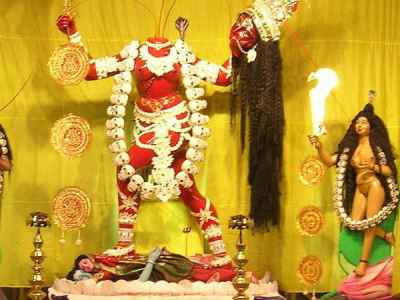- VedicFolks Exclusive Homam
- Spiritual Products
Standers 2
- VedicFolks Pooja
- Deity Idols & Statues
Standers 2
- Top Products

Chinnamasta Temple is located in Rajrappa, District of Jharkhand and is a popular pilgrimage centre in the region. The temple is dedicated to Goddess Chinnamasta, the headless deity who is the form of Goddess Durga, and is one of the Shakti Peeta temples in the country. The temple was built thousands years ago, and it is known for Goddess Chinnamasta who is shown as a self-decapitated nude Goddess standing on Kamdeo(cupid), the God of love, and Rati, the Goddess of romance, as they make love in a lotus bed. Blood is gushing out of her neck which is eventually, drunk by her head and the companions named, Jaya and Vijaya. The temple is also famous for its tantric style of architecture. The temple enshrines the Goddess Chinnamasta (the beheaded Goddess Kali), one of the ten forms of the Goddess Durga. Goddess Chinnamasta holding her own head in her left hand and her head drinking the blood fountain flowing to the neck.
MAIN ATTRACTION OF THIS TEMPLE
The main attraction of the Chinnamasta temple is the headless deity of Goddess Chinnamasta which stands on the body of Kamdev and Rati in the lotus bed. There is constant flow of blood from the neck of the idol present in the temple. This is one of the main reasons why this shakti peeta is so famous and is considered for second largest being the Kamakhya temple in Assam.
As per the story from Shakta Maha-Bhagavata Purana, Goddess Sakti, the daughter of Daksha and the first wife of the Lord Shiva, feels insulted that she and Lord Shiva are not invited to Daksha's yagya "fire sacrifice" and insists going there, despite Lord Shiva protests. After futile attempts to convince Lord Shiva, the enraged Goddess Sakthi assumes a fierce form, transforming into the Mahavidya, who surround Lord Shiva from the ten cardinal directions.
Another legend associated with Goddess Chinnamastika, Goddess Parvathi with her two friends Jaya and Vijaya went to take bath in the river Mandakini. After taking the bath both Goddess Paravathi and her friends got hungry and hence their bodies turned black. When her friends asked for food, Goddess Goddess Parvathi asked to wait for a while. But when they repeatedly asked for the food, she beheaded herself by her own sword. The three string of blood started flowing. The two strings flow towards her friends and the third string that was flowing upward helped Goddess Parvathi to settle down her hunger. Since then she was began to be called as Goddess Chinnmastika.
ANOTHER STORIES OF THIS TEMPLE
Another Stories says, Goddess Parvathi was bathing with two attendants, Vijaya and Jaya, when the attendants asked the Goddess to satisfy their hunger. After putting them off several times, Goddess Parvati looked all around and then cut off her own head. Three streams of blood came from her neck one went to the mouth of Jaya, one to the mouth of Vijaya, and the last to the mouth of Goddess Parvathi herself. At this point, Goddess Parvathi is transformed into the Goddess Chinnamasta, whose name literally means “severed head.” When they were satisfied, she put her head back on, became Goddess Parvathi again, and went home. In other versions, the attendants are named Dakini and Varnini, and Goddess Chinnamasta is standing on a couple in the middle of having sex. The couple is Rati, Goddess of sexual desire, and her husband Kama, God of romance.
IMPORTANT TEMPLE
Aspicious festival celebrated in the temple are Makar Sankranti and Vijayadashmi which attracts hundreds of devotees from nearby places. Devotees in the river to overcome obstacles and disease free life. Devotees from all over it come from to seek blessing from the Goddess Chinnamasta.
Other Famous temples are present there
Apart from this Sidhi peeta there are many other temples famous in this area. Some of them are Goddess Mahakali temple, Dus Mahavidya temple, Babadham temple.
Do:
Don't s: